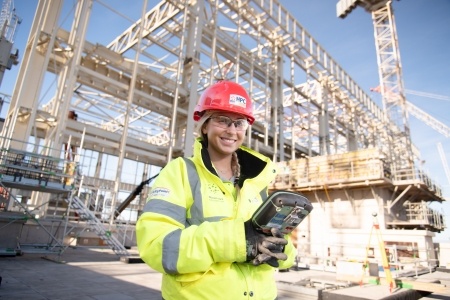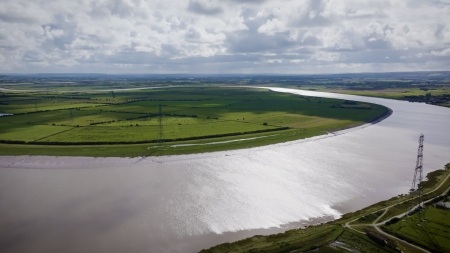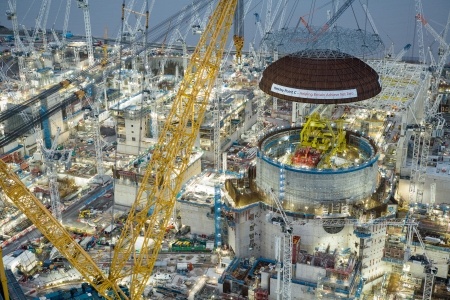
Update on Hinkley Point C project
The Hinkley Point C project successfully delivered J-0, the completion of the nuclear island “common raft” for its first unit in June 2019, in line with the schedule announced in September 2016.
Following this major milestone a detailed review of the project’s costs, schedule and organisation was performed.
The review has concluded that:
- The next milestone of completing the common raft for Unit 2 in June 2020, which was announced earlier this year, is confirmed ;
- The previously communicated risk of COD delay of unit one and two (of 15 months and nine months respectively) has increased(1)
- The project completion cost(2) is now estimated between £21.5bn and £22.5bn, an increase of £1.9bn to £2.9bn(3) compared to the previous estimate.
The range depends on the effectiveness of action plans to be delivered in partnership with contractors.
Cost increases reflect challenging ground conditions which made earthworks more expensive than anticipated, revised action plan targets and extra costs needed to implement the completed functional design, which has been adapted for a first-of-a-kind application in the UK context.
Under the terms of the Contract for Difference, there is no impact for UK consumers or taxpayers.
EDF’s project rate of return for Hinkley Point C (IRR)(4) is now estimated between 7.6% and 7.8%.
The management of the project remains mobilised to begin generating power from Unit 1 at the end of 2025. To achieve this, operational action plans overseen by the project management are being put in place. These involve the EDF Group's engineering teams in Great Britain and France, buildings and ancillary works contractors, and suppliers of equipment and systems throughout the supply chain.
(1) As previously communicated in July 2017, if this risk were to materialise, it would entail an additional cost of around £0.7bn in 2015 sterling. Under this assumption the IRR for EDF would be lower by 0.3%.
(2) In 2015 sterling, excluding interim interest and excluding forex effect versus the reference exchange rate for the project of 1 sterling = 1.23 euro.
(3) Additional costs net of action plans
(4) EDF equity IRR calculated at the exchange rate 1 sterling = 1.15 euro and including the capped compensation mechanism in place between shareholders.
This press release is certified. Its authenticity can be checked on medias.edf.com
About EDF Group
A key player in energy transition, the EDF Group is an integrated electricity company, active in all areas of the business: generation, transmission, distribution, energy supply and trading, energy services. A global leader in low-carbon energies, the Group has developed a diversified generation mix based on nuclear power, hydropower, new renewable energies and thermal energy. The Group is involved in supplying energy and services to approximately 39.8 million customers(1), 29.7million of which are in France. It generated consolidated sales of €69 billion in 2018. EDF is listed on the Paris Stock Exchange.
(1) The customers were counted at the end of 2018 per delivery site; a customer can have two delivery points: one for electricity and another for gas
About EDF
EDF is helping Britain achieve Net Zero by leading the transition to a cleaner, low emission, electric future and tackling climate change. It is the UK’s largest producer of low-carbon electricity(1) and supplies millions of customers with electricity and gas.
It generates low carbon electricity from five nuclear power stations and more than thirty onshore wind farms and two offshore wind farms.
EDF is leading the UK's nuclear renaissance with the construction of a new nuclear power station at Hinkley Point C, and there are advanced plans for a replica at Sizewell C in Suffolk. Hinkley Point C and Sizewell C will provide low carbon electricity to meet 14% of UK demand and power around 12 million homes.
EDF is one of the UK’s largest investors in renewables, with more than 1.5GW of renewable generation in operation and almost 14GW in planning and development across a range of technologies including onshore and offshore wind, solar and battery storage. We are constructing our largest offshore wind farm in Britain – the 450 MW Neart na Gaoithe project in Scotland.
EDF is helping its customers, both in business and at home, take their first steps to sustainably powering their lives. Whether it is buying an electric car, generating and storing electricity, selling energy back to the grid or installing a heat pump. EDF is one of the largest suppliers to British business and a leading supplier of innovative energy solutions that are helping businesses become more energy independent. In addition, the company’s energy services business, Dalkia, is one of the largest technical service providers in the UK and Ireland.
EDF is part of EDF Group, the world’s biggest electricity generator. In the UK, the company employs around 14,000 people at locations across England, Scotland, Wales and Ireland.
For more information
EDF Media Team
24-hour press line: +44 (0)1452 652233
media@edfenergy.com
Related articles

New Skills, Better Jobs: Report Reveals the Positive Impact of Hinkley Point C

Hinkley Point C sets out plan to create Somerset saltmarsh
